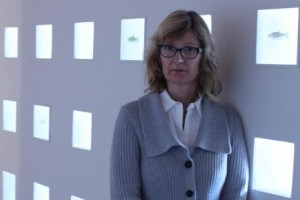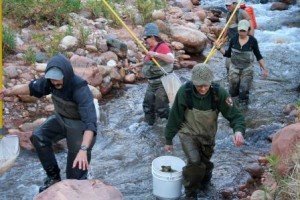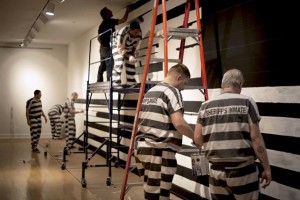October 24, 2014
 A Thought Leader Series Piece
A Thought Leader Series Piece
By Heather Lineberry
Note: Now through January 17, the ASU Art Museum hosts Trout Fishing in America and Other stories, an exhibition by artists Bryndis Snæbjörnsdóttir and Mark Wilson. The project is supported by a research grant from the Julie Ann Wrigley Global Institute of Sustainability.
Over the past four decades, solutions to the persistent and complex challenges of sustainability have typically been developed through scientific analysis. There has been an assumption that knowledge will lead to appropriate action. Recently the accuracy of this one-dimensional assumption has been in question, and many have begun to seek more effective ways of developing robust solutions.
About a year ago, Arnim Wiek from the School of Sustainability asked me to co-author a chapter for an introductory textbook on sustainability. This might seem an odd request for a contemporary art curator and art historian, but much of my research and curatorial work has explored the ways that artists have engaged with our challenges in living sustainably. I've found that art can facilitate deep collaboration across disciplines and social groups to challenge existing models and propose new ones.
A new perspective on the status quo
Art has the ability to engage us—mind and body, emotion and cognition, individual and community—with complex ideas, vivid representations and experiences. It occupies an intellectual and imaginative space that is open-ended, somewhat outside of existing behavioral patterns, and sometimes subversive, allowing for surprising and promising perspectives and outcomes.
Since the 1990s, there has been a surge in interest among artists, curators and theorists in collaborative art, called by a variety of names, including social practice. Artists or artist collectives engage directly with specific audiences and with pressing issues to produce works that vary widely in their intent. Some works encourage reflection, conversation and learning, while others develop concrete solutions by means of new objects, services and practices.
Social practice projects are social and cultural experiments that strive to build connections and dialog, and open up new, previously unforeseen pathways. They usually begin with a central question or problem, which morphs through the participatory process and is influenced by the project's location and context.
Charged and committed
One of my favorite examples of a social practice project is It's not just black and white, created in 2011 by artist and ASU School of Art faculty member Gregory Sale. During the three-month residency exhibition at the ASU Art Museum, the project explored the criminal justice system in Arizona and the United States. Close to 7 million people are in prison, on probation or on parole, and we spend $80 billion annually to keep them there. In collaboration with inmates, Sale created an installation that was a charged but safe and welcoming place. Here, crime victims, their families, corrections and law enforcement officers, activists, academics and the general public gathered to examine the underlying cycles of poverty, racism and politics in incarceration. The exhibition attracted nearly 20,000 visitors.
It’s not just black and white developed out of extensive work—over 50 events—with these diverse communities and stakeholders, who became deeply committed to participating in the dialog and in finding solutions.
Conservation and cultural change
In our current exhibition at the ASU Art Museum, artists Bryndis Snæbjörnsdóttir (Iceland) and Mark Wilson (England) explore the networks and ripple effects of scientific conservation initiatives in Arizona. Their exhibition of photographs, videos and site-specific installations, Trout Fishing in America and Other stories, takes a kind of vertical slice of the Grand Canyon.

The artists focus on the reintroduction of two endangered species: the Humpback Chub, native to the Colorado River, and the California Condor, whose zones of flight extend from the Canyon to the Vermilion Cliffs and into Utah. Working with co-curator Ron Broglio (ASU Department of English and Sustainability Scholar) over a two-year period, they interviewed and labored alongside research scientists running conservation programs for the endangered species.
The exhibition provokes wonder about human-animal interactions through strategies of humor, contradiction, absurdity, surprise and lateral (rather than direct) representation. Snæbjörnsdóttir and Wilson broaden our perspective by considering the scientific data within cultural and social contexts, compelling us to recognize how ecologies can change radically as a result of tiny individual initiatives by human or other agents.
Demarcation or collaboration
There is much to debate about these projects, and the questions are only amplified when viewed from sustainability fields. When does the project become social service, political activism or scientific documentation as opposed to art? Is it more effective or appropriate for art to visualize and occupy problems, or to propose practical solutions? How can we measure the success of these projects and based on what criteria (aesthetics, awareness, social change)?
Finally, the sciences often view artists as communicators, illustrating complex ideas for a broad public, rather than bringing new knowledge and creative strategies to the research process. What is necessary for true collaboration between artists and sustainability scientists?
Unlike conventional forms of problem-solving, social practice engages a broad range of stakeholders to experiment with alternative approaches to sustaining the viability and integrity of our societies and natural environments. Our museum’s director Gordon Knox often says, “Science and technology will be key components of any approaches to global challenges, but any long-term and real solutions will be cultural.”
These art projects create spaces for potent experiences that truly challenge conventions, habits and the preference for the status quo. My colleagues and I are less concerned with the definitions and demarcations of our fields, and more concerned with forging real progress towards sustainability.
About the author: Heather Sealy Lineberry is senior curator and associate director of the Arizona State University Art Museum and a senior sustainability scholar at the Julie Ann Wrigley Global Institute of Sustainability. Collaborating with artists, faculty and students across disciplines and with community members, her curatorial work explores how new art practices can impact decision making and change entrenched behaviors and systems. The textbook she mentions in this essay is forthcoming in 2015: Sustainability Science – An Introduction, edited by Heinrichs, Martens, Michelsen & Wiek, and published by Springer, Berlin and New York.
For more information on social practice projects at the ASU Art Museum, visit http://asuartmuseum.org/social-studies-projects.php.
Related Stories
Exhibition advances sustainability through art


